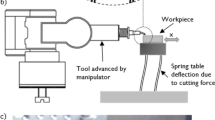Abstract
IF Mr. Mallock's friction theory of cutting-tool action is valid, and if cutting tools are ever effectively lubricated, it would follow that the dry tool should have an angle different from that of the lubricated tool. But this is contrary to universal practice. The inference would then be that either the friction theory is unimportant and extremely incomplete, or that lubrication as practised by engineers is very ineffective. The latter view seems more correct, for the following reasons.
This is a preview of subscription content, access via your institution
Access options
Subscribe to this journal
Receive 51 print issues and online access
$199.00 per year
only $3.90 per issue
Buy this article
- Purchase on Springer Link
- Instant access to full article PDF
Prices may be subject to local taxes which are calculated during checkout
Similar content being viewed by others
Author information
Authors and Affiliations
Rights and permissions
About this article
Cite this article
ROWELL, H. Action of Cutting Tools. Nature 110, 771–772 (1922). https://doi.org/10.1038/110771a0
Issue Date:
DOI: https://doi.org/10.1038/110771a0
Comments
By submitting a comment you agree to abide by our Terms and Community Guidelines. If you find something abusive or that does not comply with our terms or guidelines please flag it as inappropriate.



